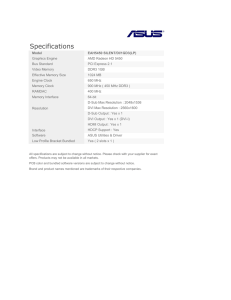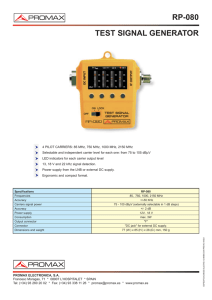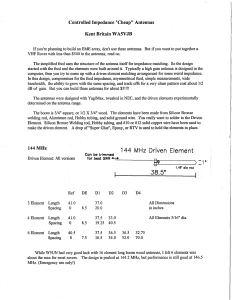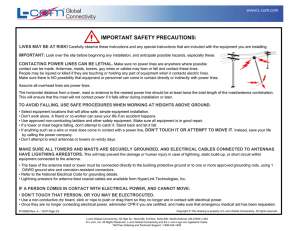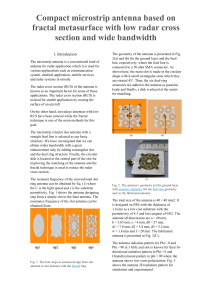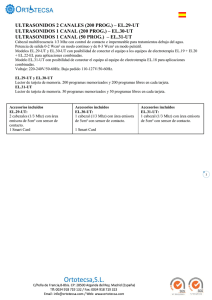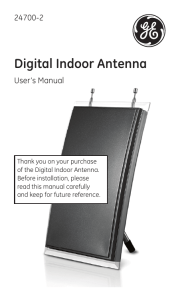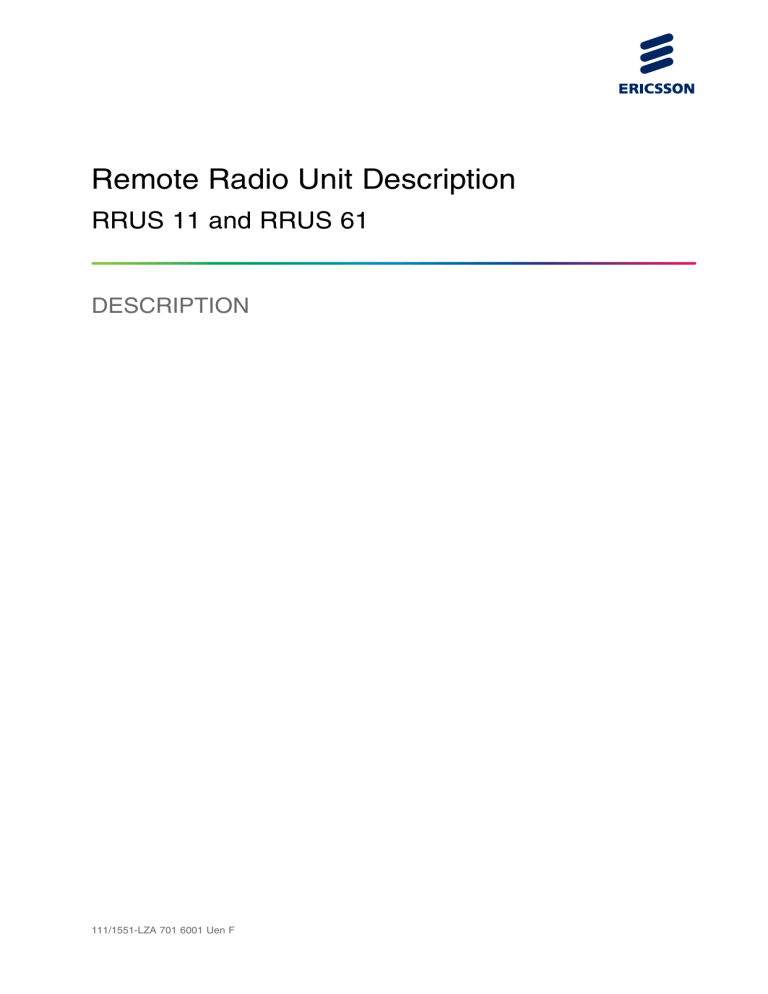
Remote Radio Unit Description RRUS 11 and RRUS 61 DESCRIPTION 111/1551-LZA 701 6001 Uen F Copyright © Ericsson AB 2011–2012. All rights reserved. No part of this document may be reproduced in any form without the written permission of the copyright owner. Disclaimer The contents of this document are subject to revision without notice due to continued progress in methodology, design and manufacturing. Ericsson shall have no liability for any error or damage of any kind resulting from the use of this document. Trademark List All trademarks mentioned herein are the property of their respective owners. These are shown in the document Trademark Information. 111/1551-LZA 701 6001 Uen F | 2012-02-07 Contents Contents 1 Introduction 1 1.1 Warranty Seal 1 2 Product Overview 3 2.1 Main Features 4 2.2 Optional Equipment 4 3 Technical Data 5 3.1 Dimensions 5 3.2 Space Requirements 9 3.3 Acoustic Noise 11 3.4 Environmental Characteristics 11 3.5 Mains Supply Characteristics 13 3.6 System Characteristics 18 4 Hardware Architecture 19 4.1 RRUS Overview 19 4.2 Solar Shield 21 4.3 Slide Cover 21 4.4 Optical Indicators and Buttons 21 4.5 PSU AC 02 (Optional) 22 4.6 RF Monitoring Port for RRUS 11 (Optional) 22 5 Connection Interfaces 25 5.1 Position A, Maintenance Button 26 5.2 Position B, Optical Indicators 26 5.3 Position C, -48 V DC Power Supply Interface 27 5.4 Position D, LMT 27 5.5 Position E and F, Interface for Optical Cable to Main Unit 27 5.6 Position G and H, Antenna Interface 27 5.7 Position I, ALD Ctrl Interface 28 5.8 Position J, Ext Alarm Interface 28 5.9 Position K and M, RXA I/O and RXB I/O Interface (RRUS 11 Only) 28 Position L, RXA Out Interface (RRUS 11 Only) 29 5.10 111/1551-LZA 701 6001 Uen F | 2012-02-07 Remote Radio Unit Description 5.11 Position N, Grounding Interface 29 5.12 Optional Equipment Interfaces 30 6 Standards, Regulations, and Dependability 33 6.1 Regulatory Approval 33 6.2 Other Standards and Regulations 35 111/1551-LZA 701 6001 Uen F | 2012-02-07 Introduction 1 Introduction This document describes the Remote Radio Unit multi-Standard (RRUS) 11 and the RRUS 61. In the document, RRUS without a model number means both RRUS 11 and RRUS 61. Note: 1.1 Remote Radio Unit (RRU) is often used as a generic expression for a remotely installed Radio Unit (RU). It is also the name of models prior to the RRUS versions described in this document, for example RRUW. Warranty Seal The unit is equipped with a warranty seal sticker. Note: Seals that has been implemented by Ericsson shall not be broken or removed, as it otherwise will void warranty. 111/1551-LZA 701 6001 Uen F | 2012-02-07 1 Remote Radio Unit Description 2 111/1551-LZA 701 6001 Uen F | 2012-02-07 Product Overview 2 Product Overview The RRUS remotely extends the reach of the RBS by up to 40 km. The RRUS is designed to be located near the antenna. A fiber optic cable connects the RRUS to the RBS main unit or an expanded macro RBS. The RRUSs can be connected in a star configuration or in a cascade configuration with optical cable links as shown in Figure 1. RRUS 11 RRUS 11 RRUS 11 Cascade Configuration RRUS RRUS RRUS Optical Cable Star Configuration Main Unit Ge1103B Figure 1 RRUSs in Star and Cascade Configurations 111/1551-LZA 701 6001 Uen F | 2012-02-07 3 Remote Radio Unit Description 2.1 Main Features Depending on the software application, the RRUS supports the Antenna System Controller (ASC), the Tower Mounted Amplifier (TMA), or the Remote Electrical Tilt Unit (RETU). The RETU can be connected either through the ASC or the Remote Interface Unit (RIU) over the antenna interface or directly using the RRUS Antenna Line Device (ALD) or Remote Electrical Tilt (RET) control interface. For LTE configurations with dual TX RRUSs, redundancy can be achieved by cross-connecting the antenna feeders between the RRUS and the antenna. For more information, refer to Cross-Sector Antenna Sharing Redundancy. The RET interface on the RRUS is the link to the antenna communication system. See Table 14 for information about the RRUS connection interface for ALD (RET). RRUS 11 supports WCDMA, CDMA and LTE FDD (depending on frequency band). It has two duplex RX/TX branches and supports cross connection of RX ports with other RRUs. RRUS 61 supports LTE TDD. It has two duplex RX/TX branches. 2.2 Optional Equipment The optional equipment for the RRUS is the following: 4 • Wall installation equipment • Pole installation equipment • Power Supply Unit (PSU) • Radio Frequency (RF) monitoring port 111/1551-LZA 701 6001 Uen F | 2012-02-07 Technical Data 3 Technical Data This section describes the physical characteristics, environmental data, and the power supply of the RBS. 3.1 Dimensions This section provides technical data and dimensions for the RRUS 11, and RRUS 61. 3.1.1 RRUS 11 Dimensions Table 1 lists the technical data for the RRUS 11. Figure 2 shows the dimensions for the RRUS 11. Table 1 RRUS 11 Technical Data Description Value Maximum nominal output power Without license key: 2x10 W or 1x20 W 2x20 W or 1x40 W (1x30 W), 2x30 (1) (2) W, 2x40 W require license keys Number of carriers Without licence key: one carrier With license keys: up to four carriers 111/1551-LZA 701 6001 Uen F | 2012-02-07 5 Remote Radio Unit Description Description Value Frequency 1920 to 1980 MHz uplink 2110 to 2170 MHz downlink B1 for WCDMA and LTE 1850 to 1910 MHz uplink 1930 to 1990 MHz downlink B2 for WCDMA and LTE 1710 to 1755 MHz uplink 2110 to 2155 MHz downlink B4 for WCDMA and LTE 824 to 849 MHz uplink 869 to 894 MHz downlink B5 for WCDMA and LTE 2,500 to 2,570 MHz uplink 2,620 to 2,690 MHz downlink B7 for LTE 699 to 715 MHz uplink 729 to 745 MHz downlink B12 for LTE (3) 832 to 862 MHz uplink 791 to 821 MHz downlink B20 for LTE 1850 to 1915 MHz uplink 1930 to 1995 MHz downlink B25 for LTE 1850 to 1910 MHz uplink 1930 to 1990 MHz downlink B25 for CDMA 817 MHz to 824 MHz uplink 862 MHz to 869 MHz downlink B26A for CDMA and LTE 6 111/1551-LZA 701 6001 Uen F | 2012-02-07 Technical Data Description Value Dimensions with Solar Shield and Handle Height 500 mm Width 431 mm Depth 182 mm Weight RRUS 11 23 kg Color Gray (1) For RRUS 11 B7, 2x30W is guaranteed for operating ambient temperatures < +50 C. For higher temperatures, 2x20W is guaranteed. (2) Detailed information about LTE licences can be found in License Management. Detailed information about WCDMA licences can be found in Licenses and Hardware Activation Codes. (3) RRUS 11 for B12 has a bandwidth that is 2 MHz narrower than 3GPP. The supported frequency corresponds to EARFCN (Channel Numbers) of 5010-5169 in downlink and 23010-23169 in uplink. The RRUS 11 size, height, width, and depth with solar shield, is shown in Figure 2. 431 182 500 Unit of measurement mm Figure 2 Ge1367A RRUS 11 Height, Width, and Depth with Solar Shield 111/1551-LZA 701 6001 Uen F | 2012-02-07 7 Remote Radio Unit Description 3.1.2 RRUS 61 Dimensions Table 2 lists the technical data for the RRUS 61. Figure 3 shows the dimensions for the RRUS 61. Table 2 RRUS 61 Technical Data Description Value Maximum nominal output power Without license key: 2x10 W (or 1x20 W) 2x20 W (or 1x30 W, or 1x40 W), 2x30 (1) W, 2x40 W require license keys Number of carriers One carrier Frequency 2302.5 to 2322.5 MHz uplink and downlink B40B for LTE 2305 to 2325 MHz uplink and downlink B40C for LTE 2320 to 2340 MHz uplink and downlink B40D for LTE 2327.5 to 2347.5 MHz uplink and downlink B40E for LTE 2325 to 2345 MHz uplink and downlink B40G for LTE 2300 to 2382 MHz uplink and downlink B40 for LTE Dimensions without Solar Shield and Handle Height 406 mm Width 416 mm Depth 128 mm Dimensions with Solar Shield and Handle 8 Height 500 mm Width 431 mm 111/1551-LZA 701 6001 Uen F | 2012-02-07 Technical Data Description Value Depth 182 mm Weight RRUS 61 21.6 kg Color Gray (1) Detailed information about LTE licences can be found in License Management. The RRUS 61 size, height, width, and depth with solar shield, is shown in Figure 3. 431 182 500 Unit of measurement mm Figure 3 3.2 Ge1367B RRUS 61 Height, Width, and Depth with Solar Shield Space Requirements This section describes the space requirements for installing the RRUS. The RRUS with cable connections running downwards can be installed as follows: • On a wall • On a pole Both wall and pole installations can be indoors or outdoors. 111/1551-LZA 701 6001 Uen F | 2012-02-07 9 Remote Radio Unit Description Pole installations can be on monopoles, masts, or towers. Figure 5 shows sample pole installations. 3.2.1 Generic Requirements The RRUS is installed with the cable connections facing downwards. Allow a minimum of 1 m free space in front of the RRUS to ensure sufficient working space. Note: 3.2.2 If no other possibilities are available, under exceptional conditions, the RRUS may be installed horizontally with the front downwards. This installation alternative limits the power supply options and the maximum output power. Details regarding optional actions can be found in Installing Remote Radio Units. Wall Installation >200 >200 >300 >1000 >400 The wall must be even within 5 mm/m. The installation requirements are shown in Figure 4. Unit of measurement: mm Figure 4 3.2.2.1 Ge1310A RRUS Wall Installation Requirements Site Layout To ensure adequate airflow between the units, allow a minimum of 400 mm free space above and 300 mm free space minimum below each RRUS. Allow a minimum of 200 mm free space between RRUSs installed side by side. 10 111/1551-LZA 701 6001 Uen F | 2012-02-07 Technical Data 3.2.3 Pole Installation The supported pole diameters are listed in Table 3. Table 3 3.2.3.1 Pole Diameters Mounting Equipment Pole Diameter Supported RRUSs Single fixture 60 – 120 mm All types Mounting bracket 35 – 155 mm All types Site Layout Allow a minimum of 200 mm free space between RRUSs installed side by side. To ensure adequate airflow between the units, allow a minimum of 400 mm free space above and 300 mm free space below each RRUS. Note: For an RRUS with AC power supply, the mounting bracket supports only two RRUS units. Figure 5 shows example pole installations (left to right: single unit on a monopole, two units on a tower on different struts, and three units on a monopole). Ge1311A Figure 5 3.3 Sample Site Layout for Pole Installation Acoustic Noise The RRUS does not generate acoustic noise. 3.4 Environmental Characteristics This section contains RRUS operating environment data. 111/1551-LZA 701 6001 Uen F | 2012-02-07 11 Remote Radio Unit Description 3.4.1 Operating Environment The following is a list of values for the RRUS normal operating environment: -40 to +55 C Temperature -40 to +45 C (RRUS 11 B1, B2, B4; in high load scenario: 2x40 W) -40 to +50 C (RRUS 11 B5, RRUS 61 B40; in high load scenario: 2x40 W) 3.4.2 Solar radiation ≤ 1,120 W/m² Relative humidity 5 to 100% Absolute humidity 0.26 to 40 g/m3 Maximum temperature change 1.0C/min Maximum wind load at 50 m/s (pole installed single case) 430 N (front) Heat Dissipation The RRUS is convection cooled. The heat dissipation value shown in Table 4 is meant to give an idea of heat dissipation when the unit is installed alone or around other RRUs. The value represents the maximum power consumption of an RRUS, taking into account optional equipment and future expansions. Table 4 RRUS Heat Dissipation Unit Output Power Maximum Heat Dissipation RRUS 11 B1, B4 2x30 W 0.34 kW 2x40 W 0.43 kW 2x30 W 0.35 kW 2x40 W 0.43 kW 2x30 W 0.26 kW 2x40 W 0.30 kW RRUS 11 B7 2x30 W 0.46 kW RRUS 11 B12, B20, B26A 2x30 W 0.32 kW RRUS 11 B25 2x30 W 0.35 kW RRUS 61 B40B, B40C, B40D, B40E, B40G 2x30 W 0.27 kW RRUS 61 B40 2x40 W 0.34 kW RRUS 11 B2 RRUS 11 B5 12 111/1551-LZA 701 6001 Uen F | 2012-02-07 Technical Data For power consumption values during traffic, see Table 9. 3.4.3 Ground Vibration This section describes the RRUS tolerance to ground vibration caused by seismic activity. The RRUS operates reliably during seismic activity as specified by test method IEC/EN 60 068-2-57. The following is a list of the ground vibration tolerance data: 3.4.4 Random vibration, normal operation Maximum 0.05 m2/s3 Random vibration, exceptional operation Maximum 0.1 m2/s3 Random vibration, non-destruction Maximum 0.5 m2/s3 Random vibration, shock Maximum 100 m/s2 Non-destructive seismic exposure, maximum level of Required Response Spectrum (RRS) 50 m/s2 within 2 to 5 Hz Non-destructive seismic exposure, test frequency 1 to 35 Hz Non-destructive seismic exposure, time history Verteq II Materials All Ericsson products fulfill the legal and market requirements regarding: 3.5 • Material declaration • Materials' fire resistance, components, wires, and cables • Recycling • Restricted and banned material use. Mains Supply Characteristics This section describes the power supply requirements, power consumption, and fuse and circuit breaker recommendations for the RRUS. The power for multiple RRUSs can be supplied from different power systems if required. 111/1551-LZA 701 6001 Uen F | 2012-02-07 13 Remote Radio Unit Description 3.5.1 DC Power Supply Characteristics The power supply voltage for the RRUS is -48 V DC. The power supply requirements are listed in Table 5. Table 5 RRUS DC Power Supply Requirements Conditions Values and Ranges Nominal voltage -48 V DC Operating voltage range -40.0 to -57.6 V DC Non-destructive range 0 to -60 V DC Fuse and Circuit Breaker Recommendations External fuse and circuit breaker capabilities for the RRUS are listed in Table 6. The recommendations given in this section are based on peak power consumption and give no information on power consumption during normal operation. The recommended melting fuse type is gG-gL-gD in accordance with IEC 60269-1. Circuit breakers must comply with at least Curve 3 tripping characteristics, in accordance with IEC 609 34. The RRUS has a built-in Class 1 (Type 1) Surge Protection Device (SPD) to protect the equipment in case of lightning and network transients. The recommended fuse or circuit breaker rating is therefore dimensioned for not tripping the fuse or circuit breaker in case of SPD operation. The minimum fuse rating could be taken into account only if it is accepted that fuses or circuit breakers trip in such situations. 14 111/1551-LZA 701 6001 Uen F | 2012-02-07 Technical Data Table 6 RRUS Fuse or Circuit Breaker Recommendations Unit (DC powered) Output Power Minimum Fuse (1) Rating Fuse Rating Recommended for Reliable (2) Operation Maximum Allowed Fuse (3) Rating RRUS 11 B1, B4 2x10 W 9A 25 A 32 A 2x20 W 10 A 2x30 W 13 A 2x40 W 15 A 2x10 W 8A 2x20 W 10 A 2x30 W 13 A 2x40 W 15 A 2x10 W 10 A 2x20 W 13 A 2x30 W 16 A 2x10 W 8A 2x20 W 10 A 2x30 W 13 A 2x10 W 7A 2x20 W 8A 2x30 W 10 A 2x40 W 12 A RRUS B2, B5 RRUS 11 B7 RRUS 11 B12, B20, B25, B26A RRUS 61 B40B, B40C, B40D, B40E, B40G RRUS 61 B40 (1) These fuse ratings can only be used if it is acceptable that fuses trip due to lightning or network transients. (2) The recommended fuse rating takes into account that external fuses are not to trip due to lightning or network transients. (3) The absolute maximum fuse class in accordance with RRUS design restrictions. 3.5.2 AC Power Supply Characteristics The RRUS AC accepts 100 to 250 V AC if it is used together with the optional PSU. The power supply requirements are listed in Table 7. Table 7 RRUS AC Power Supply Requirements Normal Voltage Range Tolerance Range 200 to 250 V 180 to 275 V AC 100 to 127 V 108 to 130 V AC 100 V 90 to 110 V AC Connection Phase-neutral Frequency range 50 to 60 Hz Voltage harmonics < 10% at full load 111/1551-LZA 701 6001 Uen F | 2012-02-07 (1) (1) (1) (2) 15 Remote Radio Unit Description Normal Voltage Range Tolerance Range Shut-off allowance At undervoltage or overvoltage Inrush current peak < 40 A Inrush current duration < 10 ms (3) (1) AC connected through a PSU AC 02 (2) Must comply with IEC 61000-3-2 (3) Alarm raised at 70 ± 5 V, ceased at 80 ± 5 V (phase voltage) Fuse and Circuit Breaker Recommendations External fuse and circuit breaker capabilities for the RRUS are listed in Table 8. The recommendations given in this section are based on peak power consumption and gives no information on power consumption during normal operation. The recommended melting fuse type is gG-gL-gD in accordance with IEC 60269-1. Circuit breakers must comply with at least Curve 3 tripping characteristics, in accordance with IEC 609 34. The PSU AC 02 has a built-in Class 1 (Type 1) SPD to protect the equipment in case of lightning and network transients. The recommended fuse or circuit breaker rating is therefore dimensioned for not tripping the fuse or circuit breaker in case of SPD operation. The minimum fuse rating could be taken into account only if it is accepted that fuses or circuit breakers trip in such situations. The PSU AC 02 is described in Section 4.5 on page 22. 16 111/1551-LZA 701 6001 Uen F | 2012-02-07 Technical Data Table 8 RRUS Fuse/Circuit Breaker Recommendations Unit (AC powered) Output Power Minimum Fuse (1) Rating Fuse Rating Recommended for Reliable (2) Operation Maximum Allowed Fuse Rating (3) RRUS 11 B1, B4, B5, B12, B20, B25, B26A 2x30 W • 7 A (100 to 127 V AC) 32 A 32 A RRUS 11 B1, B2, B4, B5 2x40 W • 4 A (200 to 250 V AC) • 8 A (100 to 127 V AC) • 4 A (200 to 250 V AC) RRUS 11 B7 2x30 W • 8 A (100 to 127 V AC) • 4 A (200 to 250 V AC) RRUS 61 B40B, B40C, B40D, B40E, B40G 2x30 W RRUS 61 B40 2x40 W • 5 A (100 to 127 V AC) • 2.5 A (200 to 250 V AC) • 7 A (100 to 127 V AC) • 3.5 A (200 to 250 V AC) (1) These fuse ratings can only be used if it is acceptable that fuses trip due to lightning or network transients. (2) The recommended fuse rating takes into account that external fuses are not to trip due to lightning or network transients. (3) The absolute maximum fuse class in accordance with RRUS design restrictions. 3.5.3 Power Consumption This section contains RRUS power consumption data. The power consumption data listed in this section refer to normal operation during traffic. Typical power consumption values are based on a realistic, typical traffic distribution that corresponds to an average output power of 40%. Cooling conditions are based on an annual temperature distribution for the Frankfurt am Main (Germany) climate zone. Optional equipment is not included. The high-load power consumption values corresponds to 100% of the maximum output power. Cooling conditions are based on a statistical maximum temperature for the Frankfurt am Main (Germany) climate zone (+30 C). Optional equipment is not included. Table 9 shows RRUS power consumption. 111/1551-LZA 701 6001 Uen F | 2012-02-07 17 Remote Radio Unit Description Table 9 RRUS Power Consumption Values Unit Output Power Typical Power(1) Consumption High Load Power (1) Consumption RRUS 11 B1, B4 2 x 30 W 0.29 kW 0.40 kW 2 x 40 W 0.35 kW 0.51 kW 2 x 30 W 0.29 kW 0.41 kW 2 x 40 W 0.35 kW 0.51 kW 2 x 30 W 0.23 kW 0.32 kW 2 x 40 W 0.25 kW 0.38 kW RRUS 11 B7 2 x 30 W 0.40 kW 0.52 kW RRUS 11 B12, B20, B26A 2 x 30 W 0.22 kW 0.38 kW RRUS 11 B25 2 x 30 W 0.29 kW 0.41 kW RRUS 61 B40B, B40C, B40D, B40E, B40G 2 x 30 W 0.25 kW 0.32 kW RRUS 61 B40 2 x 40 W 0.32 kW 0.42 kW RRUS 11 B2 RRUS 11 B5 (1) The power consumption values does not include power to optional external equipment such as RET and TMA. 3.6 System Characteristics This section describes the system characteristics of the RBS. 3.6.1 RF Electromagnetic Exposure for RBS 6000 General information on RF Electromagnetic Fields (EMF) for RRUSs connected to an RBS from the 6000 family can be found in Radio Frequency Electromagnetic Fields. Information about radio access specific compliance boundaries for electromagnetic exposure can be found in Radio Frequency Electromagnetic Exposure. 3.6.2 Software Information on software dependencies can be found in Compatibilities for Hardware and Software. 3.6.3 Radio Configurations Information about available radio configurations can be found in RBS Configurations. 18 111/1551-LZA 701 6001 Uen F | 2012-02-07 Hardware Architecture 4 Hardware Architecture This section describes the RRUS hardware structure regardless of configuration or frequency. The RRUS components are shown in Figure 6 and listed in Table 10. Note: The supported configurations are described in RBS Configurations. A C B Ge1508B 4.1 Figure 6 RRUS 11 and RRUS 61 Components Table 10 Key to RRUS Components Position Component A Solar shield B Slide cover C PSU AC 02 (optional) RRUS Overview The RRUS contains most of the radio processing hardware. The following sections describe the component units inside the RRUS. 111/1551-LZA 701 6001 Uen F | 2012-02-07 19 Remote Radio Unit Description 4.1.1 TRX The Transmitter and Receiver (TRX) provides the following: 4.1.2 • Analog/Digital (A/D), Digital/Analog (D/A) conversion • Channel filtering • Delay and gain adjustment • Digital predistortion • RF modulation and demodulation • Optical cable interface termination • Two receivers for RX diversity • RET receiver (the antenna system communication link) PA The Power Amplifier (PA) is the linear power amplifier for the RF carrier. RRUS 11 and RRUS 61 have two PAs, one for each branch. 4.1.3 FU The Filter Unit (FU) consists of band-pass filters and low-noise amplifiers. In the RRUS, the FU also provides the following: 4.1.4 • Power and supervision for the ASC, the TMA, or the RIU • Voltage Standing Wave Ratio (VSWR) supervision DC SPD The DC Surge Protection Device (SPD) board protects the DC power input from lightning currents. 4.1.5 ALD (RET) SPD An SPD provides overvoltage/overcurrent protection for the ALD (RET) port. 4.1.6 External Alarm SPD An SPD provides overvoltage/overcurrent protection for the external alarm ports. 20 111/1551-LZA 701 6001 Uen F | 2012-02-07 Hardware Architecture 4.2 Solar Shield The solar shield protects the RRUS from solar radiation. The solar shield is also part of the cooling design. Figure 6 shows the solar shield. Note: 4.3 Always attach the solar shield to the RRUS regardless of whether the RRUS is installed in a shady or in a sunny location. Slide Cover The slide cover hides the optical indicators and the maintenance button. More information can be found in Section 5 on page 25. 4.4 Optical Indicators and Buttons The RRUS is equipped with optical indicators that show system status. The optical indicators are located on the overlay marking. Table 11 describes how to interpret the optical indicators for RRUS when WCDMA and LTE controlled. Table 11 Marking RRUS Optical Indicators WCDMA or LTE Controlled Indicator Color Mode Indicates Fault Red Off No fault detected in RRUS On Fault detected in RRUS Off RRUS not operational On Power present Blink (2 Hz) Load or testing in progress Blink (0.5 Hz) Dependent resource missing Off RRUS not in maintenance mode. On RRUS in maintenance mode. Blink (0.5 Hz) Shutdown in progress Off Disconnected On Connected Operational Maintenance 1, 2 LMT Interface Green Blue (1) Green – - - Not used Maintenance - - Switch RRUS mode between Remote and Maintenance Button: (1) The color can also be yellow. The yellow optical indicator can blink busy. 111/1551-LZA 701 6001 Uen F | 2012-02-07 21 Remote Radio Unit Description 4.4.1 Maintenance Button Function See Indicators, Buttons, and Switchesfor information about the maintenance button. 4.5 PSU AC 02 (Optional) The PSU is required for the AC power input option. The PSU converts RRUS input main power 100 - 250 V AC to -48 V DC and is installed on the back of the RRUS. Figure 7 shows the PSU. A C D B Ge1673A 4.6 Figure 7 PSU AC 02 Table 12 PSU AC 02 Connection Interfaces Position Interface A Grounding interface B AC power interface C External alarm interface D DC power interface RF Monitoring Port for RRUS 11 (Optional) The RF monitoring port can be used to monitor the RRUS downlink RF output power without interrupting service. The RF monitoring port components are shown in Figure 8 and listed in Table 13. 22 111/1551-LZA 701 6001 Uen F | 2012-02-07 Hardware Architecture A 11 0 C B Unit of measurement: mm Figure 8 RF Monitoring Port Table 13 RF Monitoring Port Overview Ge1400B Position Interface A 7/16 RF connector used for connecting to interface B 7/16 RF connector for connecting the RF cable C N-type RF connector for pairing with connector on monitoring equipment (including metal protective cap to be used when the interface is not in use) or The RF monitoring port is connected to the or antenna interface on the connection interface panel at the bottom of the RRUS. The and interfaces support bidirectional, RX/TX traffic, but only the TX direction can be monitored. Using the RF monitoring port does not affect RRUS performance. RF leakage due to connecting the antenna cables through the monitoring port does not exceed that of a standard RF cable. Insertion loss between port A and port B is less than 0.2 dB. 111/1551-LZA 701 6001 Uen F | 2012-02-07 23 Remote Radio Unit Description 24 111/1551-LZA 701 6001 Uen F | 2012-02-07 Connection Interfaces 5 Connection Interfaces This section contains information about the RRUS connection interfaces. The RRUS connection interfaces are shown in Figure 9, and listed in Table 14. A B B 1 2 LMT G E F D L J I C N H M K Ge1368D Figure 9 RRUS Connection Interfaces Table 14 RRUS Connection Interfaces Positi on Description A Maintenance button 111/1551-LZA 701 6001 Uen F | 2012-02-07 Marking 25 Remote Radio Unit Description Positi on Description B Optical indicators Marking , , 1, 2 LMT C -48 V DC power supply D – E Optical cable 1 1 F Optical cable 2 2 G Antenna 1 H Antenna 2 I ALD (used for a RET unit for example) J External alarm LMT ALD (1) Cross connect RXA RXA I/O (1) RXA co-site RXA Out M Cross connect RXB RXB I/O N Grounding K L (1) (1) Applicable for RRUS 11 only. 5.1 Position A, Maintenance Button The maintenance button is located next to the left of the Note: symbol. Use a pointed object, for instance a screwdriver or a pencil tip, to press the maintenance button. More information about the maintenance button can be found in Indicators, Buttons, and Switches. 5.2 Position B, Optical Indicators Optical indicators show the system status. More information about the optical indicators can be found in Indicators, Buttons, and Switches. 26 111/1551-LZA 701 6001 Uen F | 2012-02-07 Connection Interfaces 5.3 Position C, -48 V DC Power Supply Interface The -48 V DC power connection is made through a connector. The connector accepts cables with various cross-sectional areas depending on the cable length. These cross sectional diameter tolerances are listed by cable length in Table 15. Table 15 -48 V DC Power Supply Cable Diameter Tolerances Cable Length Recommended Cross-Sectional Area of Each Conductor 0 to 60 m 6 mm2 60 to 100 m 10 mm2 The power cable conductor has a wire for the 0 V conductor and a wire for the -48 V conductor. The wire color code for both is market dependent. All cables must be shielded. The shielding must be properly connected both in the power connector and to the grounding interface in the power supply equipment, otherwise the RRUS overvoltage and lightning protection will not function properly. 5.4 Position D, LMT Not used. 5.5 Position E and F, Interface for Optical Cable to Main Unit The 1 and 2 interfaces provide connections to optical cables for traffic and timing signals between the RRUS and the main unit. An SFP is used to connect the optical cable to the RRUS. 5.6 Position G and H, Antenna Interface The antenna interfaces provide RRUS connections to antennas. RF cables connect the RRUS to the antenna. The antenna connection interface characteristics of these cables are described in Table 16. 111/1551-LZA 701 6001 Uen F | 2012-02-07 27 Remote Radio Unit Description Table 16 RRUS Antenna Connection Interface Characteristics Connector Type RF Cable Type 7/16 IEC-169-4 50 1/2-inch insert-receiver coaxial type Cable Connector Type Cable Product Number 7/16 insert-type on both ends TSR 951 70 The antenna cables must be connected as described in Table 17. Table 17 RRUS Antenna Cable Connectors RRUS Connectors (Antenna 1) (Antenna 2) 5.7 Antenna Connectors TX/RX TX/RX Position I, ALD Ctrl Interface The ALD controll (ALD Ctrl) connects an ALD (RET) cable to the RRUS for antenna system communication. 5.8 Position J, Ext Alarm Interface Two external alarms can be connected to the RRUS external alarm port. 5.9 Position K and M, RXA I/O and RXB I/O Interface (RRUS 11 Only) The RXA I/O and RXB I/O interface port is used to cross connect the RRUS 11 for antenna diversity, as shown in Figure 10. 28 111/1551-LZA 701 6001 Uen F | 2012-02-07 Connection Interfaces RXA I/O RXB I/O RRU 1 RRU 2 Ge2098A Figure 10 5.10 Cross Connecting RRUS 11 Position L, RXA Out Interface (RRUS 11 Only) The RXA Out interface port is used to co-site RRUS 11s, as shown in Figure 11 . RXA Out RXB I/O Ge2099A Figure 11 5.11 Co-siting RRUS 11 Position N, Grounding Interface The RRUS must be grounded to protect it from overvoltage and lightning strikes. The grounding interface on the RRUS accepts a small cable lug on a short, coated cable. The cable and loop is then bolted into place with an M8 bolt as shown in Figure 12. 111/1551-LZA 701 6001 Uen F | 2012-02-07 29 Remote Radio Unit Description Socket 13 mm 15 Nm Ge1506C Figure 12 5.12 RRUS Grounding Interface Optional Equipment Interfaces The equipment presented in this section is optional and can be ordered separately. 5.12.1 PSU AC (Optional) The PSU (also called the PSU AC) uses an AC power interface available from Ericsson. The AC cable is connected to the PSU with a contact on the cable. The AC connector comes with the RRUS. All cables must be shielded. The shielding must be grounded on both the PSU and the power supply equipment side with the site Main Earth Terminal (MET). Each power cable conductor can have a 1.5–4 mm² cross-sectional area. The PSU is shown in Figure 7. Note: 5.12.2 The wire color code in the external AC power supply cable is market dependent. RF Monitoring Port for RRUS 11 (Optional) The optional RF monitoring port allows either periodic or continuous downlink RF output power monitoring without interrupting RRUS 11 service. The monitoring interface can be found on the optional RF monitoring port. The RF 30 111/1551-LZA 701 6001 Uen F | 2012-02-07 Connection Interfaces monitoring port can be placed on each antenna interface that is a transmitter port. 32 mm 25 Nm Ge2102A Figure 13 RF Monitoring Interface Connection 111/1551-LZA 701 6001 Uen F | 2012-02-07 31 Remote Radio Unit Description 32 111/1551-LZA 701 6001 Uen F | 2012-02-07 Standards, Regulations, and Dependability 6 Standards, Regulations, and Dependability This section presents a brief overview of standards, regulatory product approval, and declaration of conformity. Declaration of Conformity A signed Supplier's Declaration of Conformity (SDoC) for the European market is available on request. 6.1 Regulatory Approval The RBS complies with the following market requirement: • EC market requirements, R&TTE Directive1999/5/EC 0168 Alert Mark (Class 2 equipment) Restrictions to use the apparatus may apply in some countries or geographic areas. Individual License to use the specific radio equipment may be required. Apparatus may include Radio Transceivers with support for frequency bands not allowed or not harmonized within the European Community (EC). • 6.1.1 FCC and ETL approval Safety Standards Compliance In accordance with market requirements, the RBS complies with the following product safety standards and directives: • IEC 60 950-1:2005, Ed. 2 (worldwide) • IEC 60 215 (1987) and Amd. 2 (worldwide) • EN 60 215:1989 and Amd. 1 and 2 (applicable for systems used in the EU) • EN 60 950-1:2006, Ed. 2 (applicable for systems used in the EU) • UL 60950-1:ed.2 / CSA-C22.2 No.60950-1-07:ed.2 (Applicable for systems used in North America) 111/1551-LZA 701 6001 Uen F | 2012-02-07 33 Remote Radio Unit Description 6.1.1.1 RRUS-Specific Safety Standards In accordance with market requirements, the RRUS complies with the following product safety standards and directives: 6.1.2 • IEC 60950-22:2005 (worldwide) • EN 60950-22:2006/A11:2008 (applicable for systems used in the EU) • UL 60950-22 / CSA-C22.2 No. 60950-22-07 (applicable for systems used in North America) • IEC 60529 (IP55) (worldwide) • EN 60529 (IP55) (applicable for systems used in the EU) • UL 50E Ed. 1 2007 / CAN/CSA-C22.2 NO. 94.2-07, type 3R (applicable for systems used in North America) EMC Standards Compliance The RBS complies with the following standards regarding Electromagnetic Compatibility (EMC): 6.1.3 • 3GPP TS25.113 (worldwide) • 3GPP TS36.113 (worldwide) • ETSI EN 301 489-1 (applicable for systems used in the EU) • ETSI EN 301 489-8 (applicable for systems used in the EU) • ETSI EN 301 489-23 (applicable for systems used in the EU) • FCC CFR 47 part 15 (applicable for systems used in North America) Radio Standards Compliance The RBS complies with the following standards regarding radio: 34 • 3GPP TS25.141 (worldwide) • 3GPP TS36.141 (worldwide) • ETSI EN 301 908-1 (applicable for systems used in the EU) • ETSI EN 301 908-3 (applicable for systems used in the EU) • ETSI EN 301 908-14 (applicable for systems used in the EU) • FCC CFR 47 part 2X (applicable for systems used in North America, X is Frequency band dependent) 111/1551-LZA 701 6001 Uen F | 2012-02-07 Standards, Regulations, and Dependability 6.1.4 Marking To show compliance with legal requirements, the product is marked with one of the following: 6.1.5 • CE mark (applicable for systems used in the EU) • FCC and ETL mark (applicable for systems used in North America) Type Approval Standards The RRUS complies with EC requirements regarding radio performance. The product bears the CE mark to show compliance with the legal requirements of the relevant region. 6.1.6 RoHS The RRUS complies with Restriction of Hazardous Substances in Electrical and Electronic Equipment (RoHS) Directive (2002/95/EC). 6.2 Other Standards and Regulations The standards and regulations in this section are not regulatory approved. 6.2.1 Dependability The RRUS is designed for a mean time between failures of 50 years at 20C (24-hour operation). 6.2.2 Spare Parts This RRUS complies with the Ericsson Serviceability and Spare Parts Strategy. 6.2.3 Surface Quality The surface quality of the RRUS is in accordance with Ericsson standard class A3. 6.2.4 Vandal Resistance Unauthorized access is not possible without damaging the unit. 111/1551-LZA 701 6001 Uen F | 2012-02-07 35
